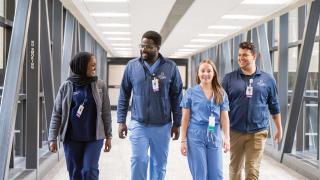Making an Impact Together
The mission of Hennepin Healthcare is vital to the health and wellness of the county and the entire state of Minnesota.
Under the leadership and oversight of the Hennepin Healthcare System Board of Directors, and in partnership with Hennepin County, our health system is improving the health and wellness of patients, attracting and training a talented healthcare workforce, conducting important research, and improving equity and access to care.
Transforming healthcare is a complex goal, but Hennepin Healthcare leadership is committed to ensuring leading-edge care is available for everyone.
Here are just a few stories from recent years that highlight how we are meeting the needs of the community we serve.
Workforce Talent and Support
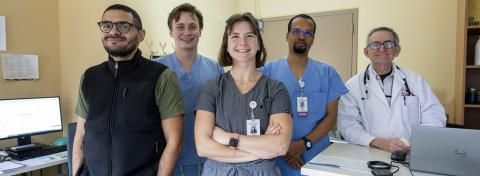
Delivering excellent care requires a workforce that has the tools, training, and support to bring their best to patients every day. Hennepin Healthcare has developed innovative programs to attract the best talent workers and help those individuals succeed.
EMT to Paramedic Program/International Physicians Residency Program/Diversity in Research
Originally published by Hennepin Healthcare (Winter 2022)
Creating Career Opportunities for Diverse Populations
As Hennepin Healthcare works to address healthcare workforce shortages, there are a number of initiatives aimed at recruiting and supporting a workforce that is more representative of the diversity of the community we serve.

Emergency Response
Hennepin Healthcare Emergency Medical Services (HEMS) has launched two efforts aimed at bringing in a more diverse workforce, including a scholarship program and an “EMT to Paramedic” initiative that helps train existing Emergency Medical Technicians to become fully licensed paramedics. There has been a national shortage of paramedics in recent years, so helping attract new and diverse candidates into this field is a high priority.
“These programs have brought some really high caliber people into our team,” said Martin Scheerer, Senior Director of EMS at Hennepin Healthcare. “Diversity is key to our growth and our efforts to provide the best possible service to the community.”
International Physicians
Another way to address the need for a more diverse workforce is by supporting and training immigrant physicians to provide care in the U.S. That’s why Hennepin Healthcare is collaborating with the Minnesota Department of Health (MDH) to support physicians who have come to Minnesota from other countries, placing them in residencies to train for primary care. By joining Hennepin’s Internal Medicine Residency, physicians who have already graduated and practiced in their home countries can help address Minnesota's primary care physician shortage.

Dr. Abubakar Hassan is one participant in this program. He grew up in a small village in Somalia and earned a scholarship to study medicine in Yemen. After medical school, he worked as a general practitioner in his home village before immigrating to the United States. His passion is to provide primary care to underserved patients, reduce healthcare disparities, alleviate their fears, and overcome language barriers between doctors and patients, making him a perfect fit for the Hennepin Healthcare mission.
"I am grateful to have been selected to train at Hennepin Healthcare,” said Dr. Hassan. “This program provides immigrant doctors living in Minnesota the opportunity to gain the necessary skills, experience, and knowledge to become well-trained internists."
Diversity in Health Research
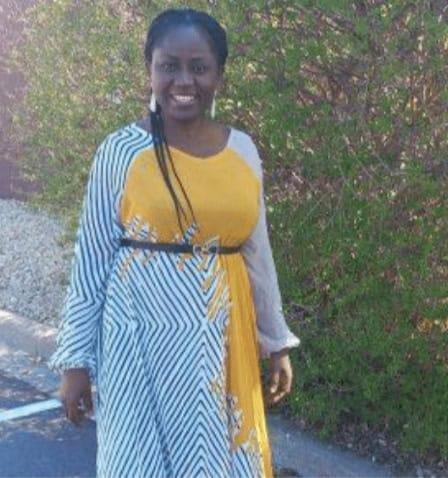
The benefits of increasing diversity in healthcare go beyond delivering care. Healthcare research also benefits when people bring different backgrounds and perspectives to their work. The Hennepin Healthcare Research Institute’s (HHRI) Biomedical Research and Career Development Award supports the training of minority and women postdoctoral and junior faculty researchers. The grant, funded by 3M, is designed to provide a clear pathway to career opportunities in STEM fields, including biomedical research. The award not only helps open new career paths, it also helps HHRI address the health issues of a broader population.
Tayo Alese studied anatomy in Nigeria and conducted research on preeclampsia in South Africa before joining HHRI, where she’s researching how tobacco use affects the healing of wounds. As a recipient of the Biomedical Research and Career Development Award, she’s getting the opportunity to work on a question that can make a significant impact on health disparities.
Alese says she’s excited about how the grant will help her future research career. “I felt it's an opportunity for me to be able to use my skills,” she said, “ and I saw that I was also going to be learning much more.”
RISE Program: Rising to the Occasion to Support Medical Residents
Originally published by Hennepin Healthcare (Winter 2021)
Rising to the Occasion to Support Medical Residents

When Dr. Abdo Barakat started his anesthesiology residency at Hennepin Healthcare, he understood it was going to be a challenging experience.
“You’re just tossed into it. You go from being someone who observes to suddenly being the one to shoulder the entire responsibility,” said Dr. Barakat. “There are busy hours, busy days, a lot of stress and a lot of expectations.”
What Dr. Barakat didn’t anticipate was the impact the job would have on his mental health. The lack of sleep, performance pressures and financial stress all added up. Dr. Barakat had dealt with mental health issues before, but this was different. As a resident he suddenly felt like he was alone, trying to hide the challenges he was facing.
“I did not want to be seen as weak. I did not want to be the topic of anyone’s gossip,” he said. “It was scary trying to hide something that a diabetic wouldn’t have to hide or a person with high blood pressure wouldn’t have to hide. But I felt like I had to hide my struggles with mental health and it became taxing.”
Fortunately, Dr. Barakat learned about a program at Hennepin Healthcare called RISE (Residents Integrated Support Environment). Through RISE, he was connected with a therapist who understood the unique pressures he was facing and who was able to meet with him despite his unpredictable schedule.
“My life turned around,” said Dr. Barakat. “I found myself finally on my A-game. I found myself more comfortable in my own skin and knowing that I’m finally delivering the way I should be delivering. And that’s when I felt like I may be a rockstar.”
Battling a Culture of “Unbreakable”
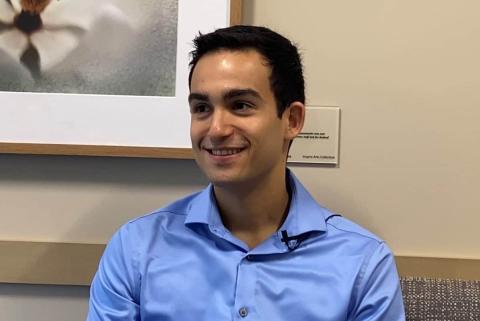
Residency is the period after medical school, when doctors start to put everything they learned into practice. They often work 80-hour weeks with very little sleep. Suddenly patients’ lives are in their hands and there is enormous pressure to not only succeed, but to excel.
“It is one of the biggest steps you take in your training,” said Dr. Zach Davidson, an Emergency Medicine and Internal Medicine Resident at Hennepin Healthcare. “It's a little bit shocking to the system initially, from being really good at taking tests and just training professionally to, ‘Okay, now you're in charge of people's lives and you need to take on this responsibility.’”
Dr. Megan Walsh, Chief Academic Officer at Hennepin Healthcare, is a founder of RISE. She says medical schools and hospitals have traditionally failed to recognize and address the unique challenges of residency.
“We select for high performers. That’s who goes to medical school,” said Dr. Walsh. “We have a culture of ‘unbreakable’ where it’s difficult to show vulnerability. Asking for help hasn’t been a part of physician culture, and we need it to be.”

The consequences of this culture can be tragic. Residents and fellows are at an elevated risk for depression. Doctors have the highest suicide rates among any profession in the United States, more than double the rate of the general population. For female physicians, the numbers are even worse. RISE is helping by addressing the mental, physical, and financial health needs of residents and fellows.
Residents who reach out to RISE are confidentially connected with therapists, primary care doctors or financial planners who are available on-site and on-demand. The goal is to reduce the barriers to care and help residents cope with stress, anxiety or depression. At the same time, the program is trying to remove the stigma that is still attached to mental health care.
“We’re trying to fight stigma within the medical community but it’s still there,” said Dr. Barakat. “It’s why a lot of us fear opening up about our issues. We fear being alienated. We fear being considered as less worthy of delivering patient care.”
Providing Tools for Mental Health
Every resident learns about RISE during their Hennepin Healthcare orientation. Dr. Katie Thorsness, a psychiatrist with the Redleaf Center of Family Healing, who also supports the RISE program, speaks to the incoming class and explains that they can’t be at their best at work if they aren’t taking care of themselves.
”Medical training is set up in a way that we are discouraged from asking for help. Asking for help is a sign of weakness,” said Dr. Thorsness. “For the residents I see it's the exact opposite. Asking for help and being vulnerable is the bravest thing that a resident can do.”
For Dr. Davidson, RISE’s message about the importance of mental health resonated.
“I think towards the end of medical school I started realizing that maybe all of this anxiety that I was feeling about studying super hard and the weight of just working nonstop and neglecting other things that were important to me - that didn't need to be the rest of my life,” he said. “We know we're all eventually going to be burned out at some point. You just need to have resources at that point to help you. I wanted to have the RISE program as another tool in my toolbox.”
Dr. Davidson met with Dr. Thorsness and engaged in cognitive behavioral therapy, giving him tools to cope and reduce anxiety even in stressful situations.
“It was like getting an operation manual for my brain,” he said. “It gave me some space between myself and my thoughts. I think that has been incredibly helpful. It’s something that has really changed my relationship with my own anxiety and made me a lot more at peace.”
The techniques Dr. Davidson is learning have even helped him take better care of patients, who often come to the hospital feeling anxious.
“Just recognizing that emotional component is super helpful,” he said. “I find my experience helps bridge a gap with patients in their own mental healthcare.”
Addressing Financial Stress
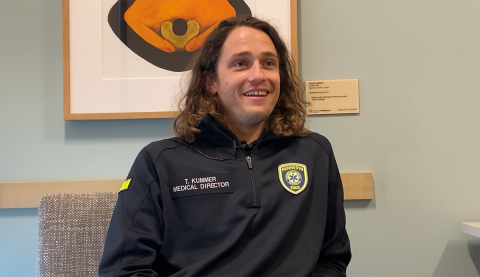
The mental health of residents goes beyond their performance on the job. Figuring out how to balance work with demands of day-to-day life can also cause anxiety. One of the biggest sources of that stress is money.
Residents leave medical school with an average of $300,000 in debt. Their starting salaries are around $55,000. Figuring out how to make that work is often outside the expertise of a physician.
Dr. Tim Kummer is an Emergency Medicine Fellow with Hennepin Healthcare. He entered his residency with three kids and then had twins during his second year. He said he had a hard time balancing stress at work with his desire to be a good dad and a good husband. Thinking about his finances only added to his worries.
“It's a really overwhelming topic. But it's like anything in life, when you shed light on it, it actually tends to get better,” shared Dr. Kummer. The more my wife and I worked with a planner it was a much bigger relief than I anticipated.”
RISE offers meetings with a certified financial planner free of charge, helping residents and their spouses or partners develop a longer term plan for financial health.
Filling a Community Need
Like the rest of the country, Minnesota is facing a healthcare worker shortage. For Hennepin Healthcare employees, the relentless nature of the COVID-19 pandemic combined with issues related to social unrest and racial injustice have pushed many workers to a breaking point. This makes attention to the physical and mental needs of residents even more critical.
“I think the same way that COVID has shed light on a lot of things, it has also shed light on burnout in healthcare,” said Dr. Davidson. “So many people have retired or stepped away because of the intensity of the work. And I think if we're going to have a sustainable pathway in medicine where we can keep at this and do this job that we love so much and work with patients, investing in our own mental health and wellbeing is an important part of that.”
The RISE program is taking direct aim at ensuring healthcare workers are ready and able to do their jobs. This can be as simple as setting up an exercise room for residents. Or it can be as fundamental as changing the culture of the workplace and letting residents know mental health issues don’t make them any less qualified to provide care to patients.
“By helping this resident, you're helping their patient. Right? Because the resident is going to be more present, more mindful, and have less compassion fatigue,” said Dr. Thorsness. “They’re also probably going to help a medical student that's with them, or they're going to help another colleague who might be in a vulnerable place. I think downstream, you're impacting a lot of different people. The ripples of impact are really large.”
This ripple effect is already being felt around the hospital. Dr. Walsh says she can measure the impact RISE is having by the numbers of physicians reaching out.
“This isn't taught in medical school,” she said. “They aren't selected for their vulnerability. They're often selected for their autonomy, for their leadership and so forth. And the more you succeed, sometimes the harder it is to show that you're hurting. And I think that's where we have to really change our culture. And this type of intervention is changing it.”
Dr. Barakat says his colleagues have noticed how his performance at work has improved since he started working with RISE, and he says he is trying to lead by example and encourage others to reach out as well.
“I'm an open book, and so people feel comfortable confiding in me,” said Dr. Barakat. “When they do, I'm very able to point them in the right directions, or to help them navigate whatever issue they have. And so, I know for a fact, that I've helped a few people.”
Dr. Walsh says she hopes the success of RISE will prompt other health care systems to offer similar support, so healthcare workers and patients can all get the quality care they deserve.
The RISE program is only possible through the generosity of philanthropy. Discover more about the critical role this resource plays and contribute at hennepinhealthcare.org/RISE.
Spiritual Care Offered to Hennepin Healthcare Providers as Well as Patients
Originally published by Hennepin Healthcare (Winter 2020)
The Power of Philanthropy - Spiritual Care
After nearly two decades working at Hennepin Healthcare, Alicia Bravo is still inspired by her job. Bravo works as a nurse in the Emergency Department. She loves being able to care for patients who are often desperate for a second chance in the face of difficult illness or trauma. Still, she admits, the day-to-day pressures can sometimes make it difficult to be at her best at all times.
“As a charge nurse I deal with families on their worst days,” said Bravo. “Trauma, stroke, pediatric cases… outsiders have no idea what we do and what we go through.”
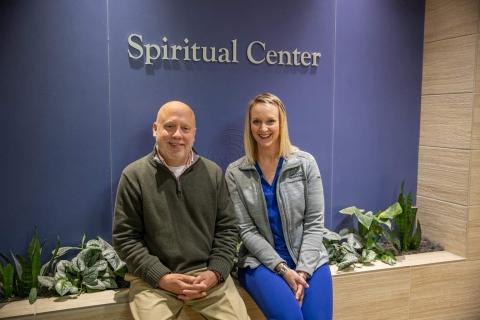
Luckily, while Bravo is working to serve patients and families, she has her own lifeline of support. Thanks to Hennepin Healthcare’s Spiritual Care department Bravo has access to a chaplain who is ready to listen and who can understand the unique pressures she faces.
“They are the light in so many of the darkest days and moments,” said Bravo. “They support our well-being. You may need it when you don’t even know it. It can be powerful and healing.”
Chaplain David Hottinger manages Hennepin Healthcare’s Spiritual Care department. While most of its services focus on patients and families, Hottinger says his team views supporting staff as just as critical.
“Health care workers are trained to focus on others. They are sometimes not as comfortable focusing on themselves,” said Hottinger. “You can get eaten alive by the stress when you are confronted with difficult situations every day. So having an opportunity to step back and take a breath is invaluable.”
Hottinger and the other chaplains on his team provide both formal and informal support to Hennepin Healthcare staff to help them work through the emotional burdens that are inherent in their jobs. They are often called in by departments after particularly stressful and traumatic cases. At other times support is delivered through casual encounters, when doctors, nurses and other staff members simply feel a need to talk.
“Often it’s a matter of giving staff a chance to be listened to, maybe to vent about an issue, and then they start to feel better,” said Hottinger. “Just the fact that we are there is often enough to let the staff know that someone has their back.”
The spiritual care team brings an inclusive approach to provide help to all patients, families and staff regardless of religious affiliation.
“It’s not about religion. It’s about connection,” said Bravo. “The chaplains bring something to us that is understood and valued under any tradition.”
“We ask them how they’re coping and how they are finding meaning in their work,” said Hottinger. “This leads to spiritual connections and a reminder of why they are doing this in the first place.”
Unfortunately, spiritual care services are not reimbursed by insurance, so philanthropy is required to provide the materials, supplies and training that are necessary for the program to succeed.
“We know the value,” said Hottinger. “We understand the impact we can have on patients, families and on the staff. All of these are critical to patient outcomes and satisfaction.
Bravo says the benefits to the Emergency Department staff and patients is hard to overstate.
“They are the light in so many of the darkest days and moments,” she said.
Whether they are at the side of the staff, helping a family through a difficult time, or are giving an emotional boost to an employee after a difficult day, Bravo says having spiritual services available is key in providing the kind of care every patient and family deserves.
Innovation and Patient Care

Meeting a community’s healthcare needs requires the ability to innovate, adapt, and rise to any challenge. Hennepin Healthcare has demonstrated a willingness to take on the toughest challenges, always focused on patient needs.
No Stigma. No Judgment. Tackling the Addiction Epidemic One Patient at a Time
Originally published by Hennepin Healthcare (Summer 2023)
No Stigma, No Judgement
Tackling the Addiction Epidemic One Patient at a Time
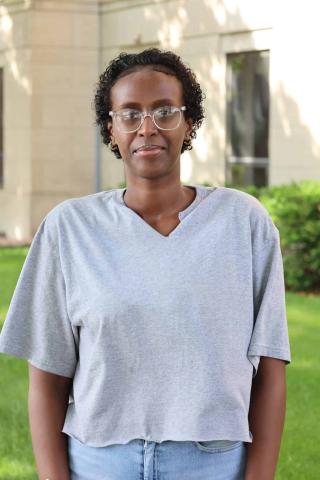
For 20-year-old Sundus Ali, addiction isn’t just a disease. It’s an ever-present threat to her survival.
“It's like standing in front of a bus and knowing the bus is going to hit you and you're going to lose everything and everyone, and still not being able to move,” she said.
Sundus was raised in an abusive home, with a father who was addicted to alcohol and drugs. She started drinking when she was eight to cope with severe physical, emotional, and sexual abuse. She got into hard drugs at 11. When she was 17, she woke up to discover her friend, who was sleeping in her room, had died of an overdose. She knew that if she didn’t get help, she was probably next.
“Something broke,” she said. “I just was like, ‘I can't keep doing this. I need to get clean.’"
After trying numerous treatment programs, Sundus eventually found her way to the Hennepin Healthcare Addiction Medicine Clinic. She said walking through those doors put her on a new path toward hope.
“To say it is literally my lifeline isn't an exaggeration,” said Sundus. “It's factual. I would probably be dead without this place, because in certain points of my life, this is all that I had.”
As is often the case with substance use disorders (SUDs), Sundus’ path hasn’t been smooth or easy, but she knows she finally has a team that is on her side.
“When we come here, we have doctors who care and who respect you as a human being,” said Sundus. “Here, if you are going to have a doctor, you're going to have 120 percent of them. When they're with you they're not answering the phone. They're not talking to anybody else. They're completely and totally focused on how they can help you.”
Tackling an Epidemic with Science and Support
To call addiction a public health crisis is, in some ways, understating the issue. Fueled by skyrocketing opiate use (including fentanyl), drugs, alcohol and nicotine have become the number one cause of preventable death in the world. In the United States, three quarters of a million people die every year from these substances. In 2021, an average of four people in Minnesota died each day from a drug overdose. Beyond the numbers, addiction takes an enormous toll on families, communities, and our social and criminal justice systems.

As a healthcare provider with a mission to care for everyone, Hennepin Healthcare has found itself in the middle of this epidemic. Between 2008 and 2020, SUD-related hospital admissions at Hennepin Healthcare increased from 23 percent to 33 percent of total admissions.
For Addiction Medicine physician, Dr. Lauren Graber, the sheer numbers show that we need to change the way we think about addiction.
“This is all of us, all of our coworkers, all of our friends, every neighborhood. This isn't just something that happens in the inner city, on the subway, or whatever the stereotype is,” said Dr. Graber. “That's why I've taken this path, because diving in here is how we make the change in the world.”
While some healthcare providers may turn away from what can seem like an insurmountable challenge, Hennepin Healthcare welcomes everyone who needs help, providing inpatient and emergency consultation as well as clinical services.
At the Addiction Medicine Clinic in downtown Minneapolis, the waiting room is often filled with patients who come from around the metro area for weekly or monthly check-ins. Many patients receive addiction treatment medication, which can be extremely effective for opioid, alcohol and tobacco use disorders, but are often stigmatized by a dangerous double standard.
“People will have cancer, and they'll tell them, ‘You need to go to the hospital. You need to get checked by a doctor,” said Sundus. “You can have HIV, and they'll tell you, ‘Go get some medicine.’ This disease is just as deadly as all of those, but people just tell you to stop. They don't tell you, ‘Go get the help that you need,’ which is what is going to save your life.”
In addition to medication, Hennepin Healthcare also provides individual counseling, drug and alcohol testing, and referrals to other medical and psychiatric services as needed. Clinic staff often connect people with outside resources to help with underlying issues, such as food or housing insecurity.
Hennepin Healthcare also plays an important role in expanding access to care through medical education and training, helping advance understanding of SUDs and treatment options. This includes engagement through Project ECHO (Extension for Community Healthcare Outcomes), which provides addiction training to more than 1,000 providers across Minnesota and beyond.
No Stigma, No Judgment
One of the greatest barriers to helping people with addiction is getting past the stigma that is often associated with the disease.
“We're in a country where people with drug problems tend to be disowned by their families,” said Dr. Gavin Bart, Hennepin Healthcare’s Addiction Medicine Division Director. “The police arrest them and they end up in jail as a criminal justice problem. They lose their jobs. They lose their housing. To be honest, the healthcare system hasn't historically done a very good job taking care of people with addictions and treating them fairly.”
Dr. Bart and his team are intent on a different approach, one focused on empathy and the creation of a “judgment free” zone. They understand every addiction story is different, and every individual deserves to feel safe and heard.
“There will never be another hospital that I go to that I feel I will get the respect that I get here,” said Sundus. “To deal with the disease of addiction, we need humanity. We need respect. Because we don't feel as if we have it. We feel shamed. We feel different. We feel like losers.”
Dr. Graber says these feelings are common, which is why it is critical to help patients know they are valued.
“Stigma is something that all of our patients walk in the door feeling,” she said. “It's not only something they feel from other people, it’s also something that they feel within themselves. I feel like my job is making sure they know, ‘You are welcome here at any point, whether that be today, whether that be next week or next year, you have a place where you can be your wholehearted self.’"
Fighting Misperceptions, Finding Cures
Substance abuse disorders are shrouded in myth and misperception, which can prevent people from seeking the help they need. For 37-year-old Sarah Andrews, the stereotypes around addiction allowed her to hide her disease and kept her from getting treatment.
“I was very high-functioning. I had three businesses, three children, PTA meetings, soccer games,” said Sarah. “On the outside looking in, you would've never known I was addicted and struggling every single day with hard drug use.”
Sarah was born addicted to heroin and cocaine due to her mother’s drug use. She was in a medically induced coma for three weeks as a newborn. When she was 13, she started drinking regularly. Around 16 she started using drugs like methamphetamines. While at first it seemed like a social activity, things quickly turned.
“I knew the way that I used wasn't normal,” said Sarah. “I could look around me and realize that nobody else was using the same way that I was using. At a certain point, it's not about getting high anymore. It's about not getting sick and it feels like survival.”
Sarah sought treatment, visiting a number of centers and trying a variety of therapies, but nothing seemed to work. At one point she started to believe she was destined to repeat the cycle of treatment and relapse over and over again. She lost custody of her children and felt like she was spiraling out of control.
“When you lose everything and you try to take your own life, you have literally no lower to go,” she said. “When there's nothing else that can be taken from you, there's nothing else you can destroy or give away or hurt yourself by doing… then grace is possible.”
Thankfully, Sarah’s story took a different turn when she tried a new medicinal treatment called Sublocade®, a monthly injection aimed at curbing cravings for opiates. She said the injections, combined with the care she has received at Hennepin Healthcare, have been a game-changer for her recovery.
“I had tried many other clinics,” she said, “but the care that I found here, the love, the understanding, the compassion, the true interest in my recovery, has been unparalleled.”
For the Addiction Medicine care team, stories like Sarah’s show the promise and potential of the work they do.
Expanding Reach and Advancing Care
Unfortunately, the need for treatment is only getting more profound. Last year in Minnesota there were around 125,000 people with an untreated illicit drug use disorder, and around 250,000 people with untreated alcohol use disorder. Those numbers drive Dr. Bart to do more, to be sure every patient has a path to the treatment they need. This is also why the Hennepin Healthcare Foundation is working to establish an Endowed Chair for the Addiction Medicine Program, to provide funds that will improve access to care, support research, and help advocate for policies that address root causes of addiction.
“We're the hospital that's open 24/7,” said Dr. Bart. “We are the hospital that takes everyone, and we need to make sure that people who are struggling with substance use know that there's a safe place for them to come. There's so much need, and we need to be able to build that capacity.”
Saving Lives for Brighter Futures
While the addiction epidemic can be hard to wrap your arms around, the Clinic staff focus on making a difference one person at a time.
Sarah is building on the success of her treatment, holding down two jobs where she uses her own experience to help others facing addiction. She’s also on a path to regain custody of her kids, a goal that has been made possible by the medication she receives and support from her care team.
“It's something that I can count on,” said Sarah. “It's something that's consistent. It's something that's personally saved my life, and not just the care and compassion part, but there's other pieces involved here. They have support services and resources. They make sure that you can find a meeting if you need one, or food if you don't have any, or transportation if that's a problem. The care comes from so many different angles here that it's admirable.”
For Sundus, the personal attention from the clinic has helped her through some of her darkest times. During one particularly bad stretch after a relapse, Sundus went to a bridge with the intent of ending her life. As she sat on the railing listening to a song, getting ready to jump, she received a notification from her “MyChart” account. It was a message from her doctor telling her he was looking forward to seeing her at her appointment that week.
“At that point, I had felt so alone, and so isolated, and so trapped, and so worthless, and useless, and unlovable,” she said, “that little message, that little, ‘Can't wait to see you,’ literally saved my life.”
Since then, Sundus has gotten back on track with her treatment and she has even referred some of her friends to Hennepin Healthcare, telling them about the personalized care she has received.
“We might be addicts, and we might be a little rough on the edges, but when we're in here, we're kind to each other,” she said. “It's mostly because of the environment we're in. Because the people here are kind to us, we become kind to each other.”
The combination of science, empathy, and outreach has helped Hennepin Healthcare earn a reputation as a trusted resource for a population that has often had a hard time letting themselves feel vulnerable and trusting others. While the numbers may say the addiction epidemic is only becoming more daunting, Hennepin Healthcare’s Addiction Medicine team refuses to give up, knowing each individual and each story offers hope for a healthier future.
Positive Care Center — Exceptional Care without Exception
Originally published by Hennepin Healthcare (Summer 2022)
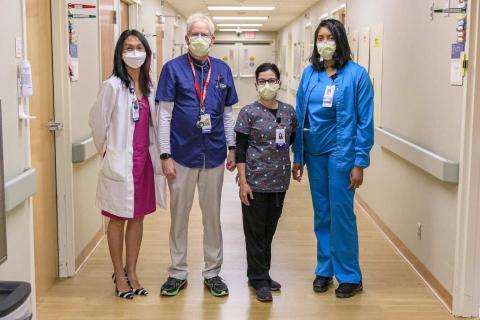
Positive Care Center - Exceptional Care Without Exception
In 2005, while he was out for a bike ride, Matt Larsen decided to stop into a clinic for an HIV test.
“I had no money in my pocket, I had no schedule that day. It was a random thought just to check my status so I did it,” he said. “About 20 minutes later, my life changed.”
Reeling from the news that he tested positive for HIV, Matt found his way to the Positive Care Center at Hennepin Healthcare (PCC). As scared as he was walking through the doors, he said he soon realized he was in the right place.
“I remember just trembling and shaking with adrenaline being thrust into this new place in a situation that was so grave and so grim,” he said. “But I knew right away it was a good place for me to be because of the receptionists, and the warmth, and the humanity displayed to everyone I witnessed sitting in the waiting room.”
Under the care of Dr. Keith Henry, Matt began a journey at the PCC that has evolved as his health needs and available treatments have changed. One thing that has stayed the same is his feeling that he found a place that accepts him, listens to him, and has embraced him every step of the way.
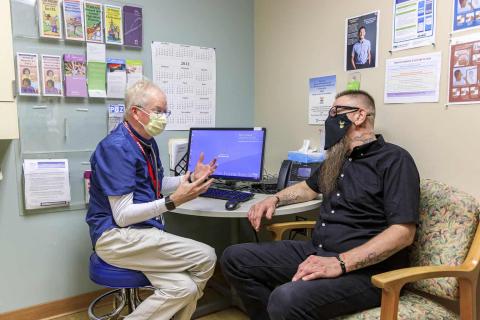
“When you’re in the waiting room, you can tell there are people who are living on the street sitting next to people in tailored suits, and we’re all treated the same. We’re all in the same place,” he said. “Just talking about it, it still brings me to this place of acceptance and understanding.”
“That team helped me realize HIV isn’t the death sentence everyone thought it was,” he continued. “It can be scary but you have to move through it. There’s no shortcut. And it’s so important knowing there are supportive, kind people behind those doors who are there to help.”
Teamwork and the Power of Kindness
Hennepin Healthcare first opened a dedicated HIV Clinic in 1981, as the AIDS epidemic was first starting to spread across the United States. It was renamed the Positive Care Center in 2005. The mission of the Center was to create a safe space for patients who were often stigmatized and isolated due to fear, misunderstanding and prejudice about the disease. That mission continues to this day as the staff works to create a supportive environment where every patient, regardless of their ability to pay, can get the best care while being treated with respect and dignity.
“In those early days, when there wasn’t much we could do for patients scientifically, I learned things they don’t prepare you for in medical school,” said Dr. Henry. “The power of words and touch become important. Listening and helping people not feel isolated. Many patients look for every reason not to return to the clinic, so it’s the kindness you can show people that may catch them off guard and will help bring them back.”
The patient experience at the PCC is the result of a team approach. Every staff member understands they play a part in creating a welcoming environment. That includes supporting patients and each other.
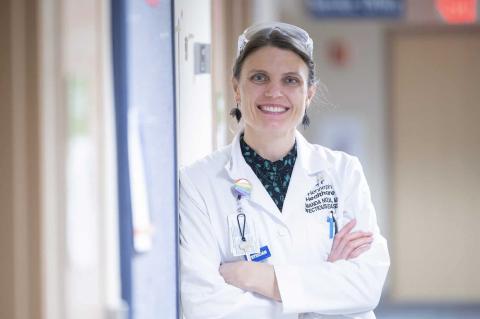
“It's hard work to absorb all of the chaos and sadness and suffering in the world, and each and every individual within PCC does that multiple times a day,” said Dr. Amanda Noska, Medical Director of the Positive Care Center. “So, we make a concerted effort to try to support one another and our patients.”
“We're all positive here,” said Patient Services Coordinator, Lashaina Jones. “We all look forward to coming here every day, seeing the patients and their smiles. Everyone from our front desk team, our medical assistants, to our providers, we all give a warm feeling to let the patients know that they are okay, they are in good hands, that they don't have anything to worry about.”
Scott Pfeifle has been a patient of Dr. Henry since he was diagnosed with HIV in 1987. He says when he started coming to the Positive Care Clinic, he immediately noticed it was a special place.
“There's no judgment involved if you come in. There's a lot of compassion and a lot of resources that you might not find at other places,” he said. “They're really nice. They know your name and they pay attention. Their level of humanity and professionalism, I can't say enough about. They've been wonderful.”
Research coordinator, Leah Westberry, said she and her colleagues work hard to create this kind of environment.
“It's not just a clinic. It really is a home,” said Leah. “People can get support and resources and bring their friends and family members if they want to have them educated about their disease. It really is that one stop shop. There isn't another clinic that offers everything that Positive Care does.”
Life-Saving Research
The PCC is grounded in a commitment to not only provide the best care, but also to advance new care models and treatments through research. This commitment has helped the Center play a role in changing the outlook for HIV patients.
Through the 1980s and in the early 90s, HIV was a death sentence. Clinics were primarily aimed at helping patients manage the disease and die with dignity. Then, in 1995, after a whirlwind global research effort, the landscape suddenly changed. That’s when the Food and Drug Administration approved the first protease inhibitor for treatment of HIV.
“I had about a 75 percent reduction in the death rate from ‘95 to ‘96 in my practice,” said Dr. Henry. “It was like a ski slope of people dying and then all of a sudden they weren’t.”
Doctors described a phenomenon called the “Lazarus Effect,” where patients who were in the final stages of hospice care received the new drugs and made miraculous recoveries. It was a game changer that prompted the Positive Care Center to evolve.
“So suddenly we were able to stop the progression of the disease, but here's 20 pills,” said Dr. Ron Schut, physician at the Positive Care Center. “We had to ask new questions. What are the obstacles to getting these into your system? How do we manage side effects?”
The new treatments ushered in new relationships with patients. Suddenly the Center was able to think beyond a five-year window for patients to look at long-term needs and quality of life. Dr. Noska says the way the PCC was able to evolve is what sets it apart today.
“We provide primary care to folks living with HIV. And I would say the vast majority of clinics treating people with HIV do not do that,” she said. “Most of the others get you on the medication and then send you to others to deal with the high blood pressure, substance use disorders, schizophrenia, whatever else might be impacting a patient. We serve both roles and it’s a heavy lift, but it's the best care. And we're all in on that.”
Treatments for HIV are continuing to evolve in ways that improve both outcomes and quality of life, and the PCC is staying on the leading edge. Today many patients take only one pill a day. The Center is also leading the way in injectable drugs that only need to be administered every month or two. Each improvement represents a step forward and a meaningful change in the lives of patients.
“When I started out taking meds, for four or five years I was taking pills every 12 hours,” said Matt Larsen. ”I told my doctor, ‘I feel like I'm on a countdown watching my life tick away 12 hours at a time?’ He understood and we changed to once a day. He absolutely was ready to accommodate that request and that adjustment for my mental and physical health.”
Addressing Needs Beyond HIV
As the virus treatments have improved, the need to address issues beyond HIV have increased. That’s why the Positive Care Center has worked to expand services aimed at addressing broader health and wellness needs. Thanks to funding from the Ryan White CARE (Comprehensive AIDS Resources Emergency) Act, and generous support from the community, the PCC team is able to provide vital wraparound services and support to patients.
The Positive Care Center is the largest recipient of Ryan White grants in Minnesota. Patients who qualify for Ryan White funding don’t have copays on prescriptions, which can cost thousands of dollars each month. They are also not billed for their appointments.
Philanthropic support from the community answers patient urgent needs for food, clothing and appointment transportation. Team members understand all of these factors are critical in helping patients walk a tightrope to stay on track with their treatment.
“We try to let everyone know what resources are available to them in the community. We also provide direct help with clothing or with food bags catered to their cultural needs,” added Lashaina. “It’s about helping patients and knowing that you saved them in a crisis. Just to see them smile, that's the most rewarding part, seeing that I've been able to do something to help someone else.”
Making Sure Nobody is Left Behind
Of course, there are some issues that the Positive Care Center can’t completely solve. Issues of racism, homophobia, transgender discrimination and a still persistent stigma surrounding people living with HIV all present significant barriers for patients.
“There's internal stigma and there's external stigma,” explains PCC nurse, Rachael Givot. “There's the personal shame where people think, ‘I got HIV. I'm broken.’ Then there's the external stigma where people are too afraid to tell their family or they’re worried someone will put it on Facebook and spread their status over social media. Stigma is huge and it's the hardest part of the job, for me, because it's so hurtful for people and it's something I can't fix.”
While the Center can’t eliminate these issues, the team feels their approach to care can at least provide an oasis of peace and acceptance in people’s lives.
“It takes all 76 employees and the village honestly,” said Dr. Noska. “It's really hard to pull off without the right group of people, but I'm confident we have them. Our front desk team is the heart and soul of our clinic. They know all 2,700 patients by first name even with masks on! Our medical assistants make people feel like they came home. Our nurses know how to talk people down in really unbelievable scenarios. That's the secret sauce and I'm really grateful to be a part of this group.”
“Ninety percent of what we deal with in an HIV clinic is not HIV,” said Dr. Henry. “It’s true that many of the things, there is no easy fix for, but kindness helps. It helps people come back. You can try to address one problem after the other. But I would say the glue is kindness.”
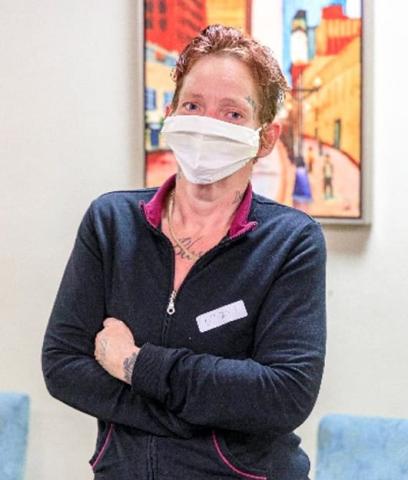
“I'll do whatever it takes,” Rachael continued. “I'll meet patients at the backdoor if they don't want to sit in the lounge. Or I'll meet them in the pharmacy and walk them down to the clinic. Now that telemedicine is available, that's helped patients a lot because sometimes it's the coming to clinic that's so hard for them. I always say, ‘I'm so happy you're here. Thanks for coming in today.’ And hopefully, eventually, we can get over some of those barriers.”
While he doesn’t have to visit as often as he used to, with his virus under control, Matt Larsen says the PCC still fills a valuable place in his heart.
“It's just so comforting and it has a familial feeling. All I can equate that too is unconditional love, which I'm only figuring that out as I say it,” he said. “It brings tears to my eyes. It was the first time in my life where I felt that from everyone who surrounded me. It still makes me emotional. It's a very powerful thing.”
As drugs and treatments continue to improve, the Positive Care Center will evolve, particularly as the HIV population starts to age. Where once they were lucky to have a patient for a few years, now they have an opportunity to develop relationships that last decades. The team members say they welcome the challenge, and they look forward to finding new ways to continue serving the needs of everyone who comes through their doors.
COVID Trauma Team Response
Originally published by Hennepin Healthcare (Summer 2021)
Emerging Threat/Getting Ready for a Pandemic
You can plan. You can train. You can read and study and prepare. But when a pandemic is approaching your doorstep, you need to act. By late January 2020, employees across Hennepin Healthcare realized COVID-19 was coming and it was going to change everything. That meant everyone had to figure out how to be part of the solution.
Drawing on the experiences of hard-hit communities overseas and on the west and east coasts, staff worked to absorb the lessons of the pandemic response. Personal protective equipment (PPE) requirements, air-flow and ventilation needs, visitor protocols, bed and ventilator shortages...there were so many questions to answer with no time to spare.
Recognizing the need for a coordinated response, leaders opened the Incident Command Center and staff mobilized across the organization. The pandemic would soon be here.
Lab
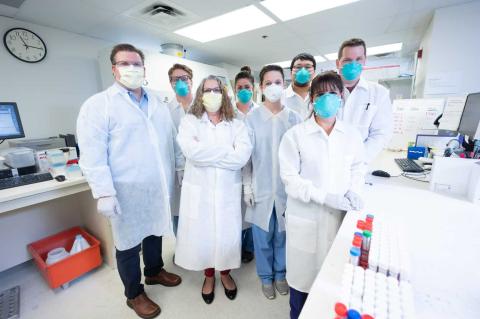
Listening to and learning from international connections built over years in the industry, Dr. Glen Hansen, Director of Hennepin Healthcare’s Clinical Microbiology and Molecular Diagnostic Lab, understood the urgency of placing orders for critical testing supplies and equipment. So by the time COVID-19 testing began in March, his team had already secured more than 200,000 test kits. The lab increased staffing from four to 15 full-time medical technologists and extended shifts to provide 24-hour coverage.
This preparation propelled Hennepin Healthcare to the forefront of virus testing for patients, staff, and community members, with the ability to process up to 2,000 tests per day. The lab was the first in the state to provide testing for open public walk-in testing, perform saliva tests and to return results for patients in less than 24 hours.
“Getting rapid turnaround from our lab - in some cases less than 70 minutes - is crucial not only for screening asymptomatic inpatients, but also for those with symptoms whose course of care is determined by this diagnosis,” said Dr. Hansen.
Hennepin’s long tradition of excellence in medical education, research and innovation has created lasting industry relationships all over the world. These relationships become invaluable in the face of a global pandemic.
PPE and Supply Chain
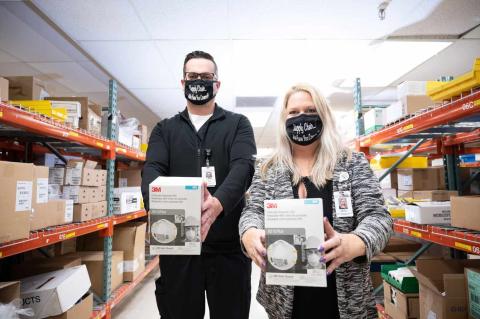
From the beginning of the pandemic, it was apparent the first line of defense was not a vaccine, it was masks, gloves, goggles and ventilators. Shortages of Personal Protective Equipment (PPE) were being reported around the country. Stories of doctors and nurses who had to wear the same N95 mask for entire weeks, or of Intensive Care Units that were exploring ways to have patients share ventilators, illustrated that supply chain logistics were going to be critical to saving lives.
In early January, long before COVID-19 was declared a pandemic, supply chain leadership started working with clinical leaders and infection control to develop a plan. They looked at data and case studies to determine needs and identify possible shortages. They had to get creative and look for new vendors to be sure they would be able to handle a possible coronavirus surge.
“It was challenging but we’re built to be proactive,” said Luis Valadez, Senior Director of Supply Chain. “We could either sit back and cross our fingers or we could step up. It was stressful but we knew that everything we brought in, every vent, every disinfectant wipe, every piece of PPE would be put to good use.”
In addition to bringing in more supplies, staff worked on protocols to be sure people knew when to use PPE and how to wear it effectively. PPE carts were stationed in patient care units along with specially trained “PPE Buddies” who helped make sure doctors and nurses were protected before entering patient rooms.
Thankfully, increased manufacturing, creative approaches to sourcing, and community donations have made PPE readily available, allowing staff to stay safe and ready to withstand the long lens of this pandemic
Trauma Response

As a Level I Trauma facility, Hennepin Healthcare had a responsibility to prepare not only for an influx of COVID-19 patients, but also to safely handle the wide variety of trauma cases that normally come through the doors. This meant that new precautions had to be put in place. Every patient suddenly had to be treated as a potential COVID-19 carrier.
Emergency Department doctors, nurses and staff leapt into action quickly to figure out ways to keep everyone safe while providing the best possible care.
“We were able to create a completely new space, a second stabilization room, just for COVID-19 patients,” said Dr. Tom Wyatt, Medical Director of the Emergency Department. “We collaborated, came up with a plan on the fly, and got it done.”
The development of new space required multiple teams working together addressing things like air flow, technology, infection control, and communication among team members who were suddenly trying to collaborate through masks and face shields.
In many ways, trauma care is all about teamwork and innovation, so when coronavirus arrived, the trauma team was ready.
Technology
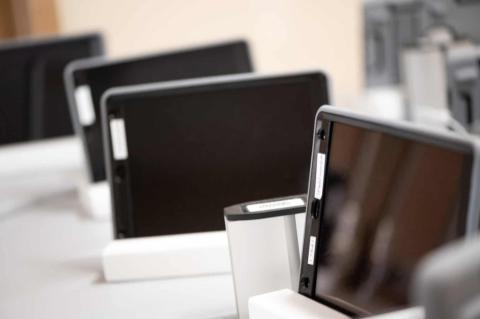
The coronavirus pandemic forced healthcare providers to dramatically increase their use of digital tools. At Hennepin, this meant not only speeding up the purchase, training and rollout of technology, but also figuring out how to connect these resources with the staff and patient population.
When more than 1,500 employees had to start working from home in late March, Hennepin’s Information Technology department worked around the clock to support this transition. They updated software, built infrastructure and researched various tools to allow staff to connect through more robust and secure online systems.
During this intense period, all nonessential/nonemergency clinic visits were cancelled. To be able to continue to care for our patients and make sure they did not feel abandoned, Hennepin quickly ramped up virtual care, including telemedicine and live video visits. Within 48 hours, Dr. Deepti Pandita and her informatics team created a telehealth service, answering patients’ emails through an electronic medical records portal. Three weeks later, the service was fully running with added video and audio capabilities as well as links to video visits in Somali and Spanish.
Interpreters

When you serve a diverse population, preparing for a pandemic requires a multicultural approach. On a concrete level, this presented a problem figuring out how to communicate with patients and families who speak another language.
Hennepin Healthcare interpreters are used to being in patient care areas, working alongside doctors and nurses. As the coronavirus spread, they knew this would have to change.
Suddenly interpreters had to prepare for virtual visits, speaking with patients, families, nurses and doctors over a screen.
“It was quite sudden and at first. We were told we could only go on the floor in emergencies, for stabilization, and then we had to wear all the PPE,” said interpreter Gina Testa. “It takes getting used to, whether we’re wearing masks or we’re on a screen, trying to talk people through a difficult and scary time.”
With a virus like COVID-19, interpreters took on another role, helping alleviate the isolation and loneliness of patients who couldn’t have any visitors. By preparing early and adapting to the challenges, they were able to be a source of comfort for patients in the time of their greatest need.
Security
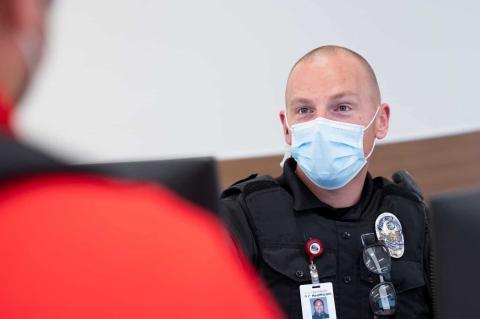
An unprecedented pandemic also calls for unprecedented efforts to maintain a safe, secure environment for patients and employees. This meant new security protocols had to be developed and executed in a matter of days.
Security personnel had to react quickly to new guidelines that were put into place around PPE and perhaps the most challenging issue, visitor guidelines.
“It was a huge change and it happened quickly,” said Sergeant Jose Luna. “We had to lock things down and not allow any visitors. It was hard to tell families that they couldn’t visit, but I tried to always do it in a way that shows I understand and I care. I try to put myself in their place and think, ‘If that was my family how would I want to be treated and made to feel better?’”
Security personnel put in long hours closing down some entrances and making sure the hospital remained a safe place for patients and employees alike.
Hero Profiles
Luis Valadez - Senior Director of Supply Chain “I love my team and I am proud of the way they signed up for work that they had never done before. I had people volunteering to assemble testing kits. Contract specialists were helping source masks. Our leadership team was at the dock helping bring in beds and sterilizing equipment. There are no silos when we are working through a pandemic. We have had to get outside of our comfort zones to make sure the clinical staff is comfortable with their safety when they are stepping into a room with a patient. That’s the urgency and the responsibility that we feel everyday.” |
Image

|
Jill Carter - Exercise Physiologist/Cardiac Rehabilitation and “PPE Buddy” “When my normal outpatient duties were taken away, I asked myself, ‘What can I do?’ I felt a need to contribute even in the chaos. We’re used to helping people everyday and it didn’t feel right to not be involved when I could do something to help at my hospital. I got trained on how to help people with PPE and I went to the units with the COVID-19 patients to make sure all the doctors and nurses knew what to do to protect themselves. People are putting themselves in harm’s way for patients and they’re so busy, I can help them remember to do things like tuck their cuffs into their gloves and put on their eye shields. I was worried at first people would see me as intruding and telling them what to do but people are so appreciative and collaborative. We’re all under the gun so let’s get through it.” |
Image

|
Thomas Wyatt, MD: Medical Director - Emergency Department “Putting on personal protective equipment is uncomfortable. It gets very warm and it makes it challenging to communicate. Masks, gowns and face shields can be barriers as you are working quickly to care for patients. But when our team gathers together and we’re putting on our PPE, it fosters a sense of teamwork. We game plan together and we look out for each other. In many ways COVID-19 is presenting us with challenges we have never dealt with before. At the same time, seeing how people respond has been inspiring. Yes, we’ve seen very sick patients. But the professionalism and commitment I’ve seen shows that we are more than up for the challenge.” |
Image
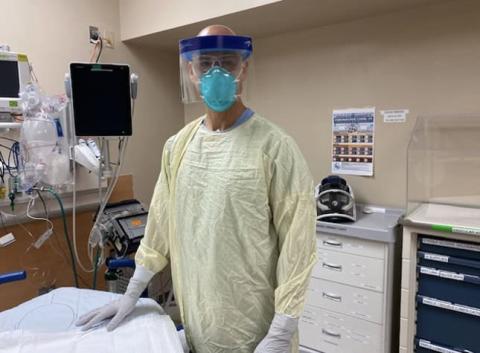
|
Colleen Crampton - Director of Laboratories “This was like a slow moving tornado heading our way and we had to get prepared. We had to think about equipment, logistics, supplies, and there were challenges nobody could have anticipated. For example, all of the swabs that we need to conduct testing for coronavirus are made in Northern Italy. All of them. And suddenly Northern Italy was shut down. Our team is full of problem solvers. We moved quickly to make sure we had the staff in place, the supplies we needed, and the knowledge about how to get testing done. We were one of the leaders in the state in getting our testing set up and available quickly. I wasn’t surprised by this because we believe in Hennepin Healthcare’s mission: serving underserved populations… serving everyone. We knew we just needed to get this done.” |
Image
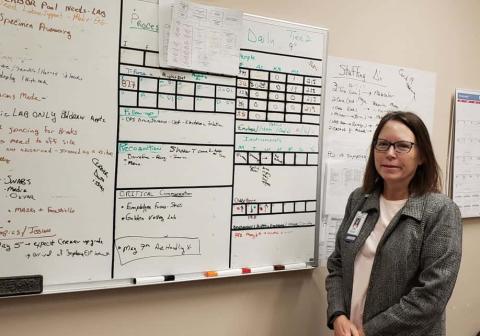
|
Nicole Grimlie, RN: Senior Staff Nurse - Emergency Department “When you’re working in a stabilization room it is crowded. It can get hot and you’re there for multiple hours at a time. Wearing the PPE, the N-95 masks, you don’t really get deep breaths so you can start to feel light headed. It’s difficult to hear and people’s voices are muffled. It’s been difficult but we have a strong teamwork approach and it’s become even stronger. We do game planning and preparation beforehand. We work on clear and concise communication. We even try to find humor and make each other smile. We all come from different backgrounds but we come together as a team. I’m proud that, even with all the challenges, we’re still all focused on compassionate care.” |
Image

|
Catherine Gonzales-Klang, Interpreter “It’s definitely hard as an interpreter to have to do so much remotely. I sit in my office most of the day looking at a screen and trying to help when usually I’m walking around and working in person with patients and the staff. It’s very isolating. Usually the remote connection goes well, but there are times it’s more difficult, especially with elderly patients. One of my first patients with COVID-19 had to be intubated and was sedated and I was just trying to explain to her what was going on. Sometimes, particularly when the patient is having a hard time breathing, I have to take a moment after a call to try to calm myself, stay strong, and not cry.” |
Image
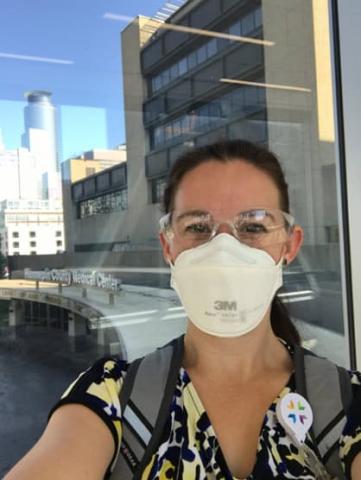
|
Jose Luna, Security Officer “I was born and raised in New York so when everything started happening I got to be so nervous about whether I’d be able to see my family. Would things ever get back to normal and be like they were before? Then I saw the way people stepped up and showed how much they cared about each other and the work we do. We all play a part and we’re all important pieces of the family. So even when we have to do things like change visiting policies and keep people apart, we’re doing it in a way that shows we understand and we’re there for the families. We’re all part of a big family and that’s helping us do what’s needed to keep everyone safe.” |
Image

|
Paul Trudeau - Operations Manager “We knew how important it was to get a COVID testing clinic set up and ready very quickly. It had to be separate from inpatients and close to the outside so we could easily get patients in and out. We got to work and turned the whole thing around in two days. That’s how we’ve managed through this whole thing. Everyone pulls together because this is what we need to do. When this is over people will remember the support we gave each other, the relationships that we developed across departments. It reminds us that we’re all here for the same reason: to treat the ill and make sure everyone is safe.” |
Image
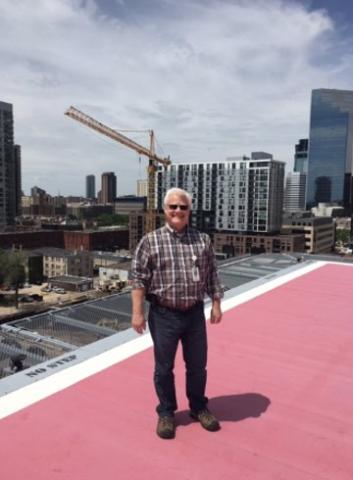
|
Fedlu Awol, Medical Technologist “My wife is a pharmacy technician working with COVID patients and we have two school-aged kids. We talk about it a lot and we take precautions. My kids know when I get home there is no hugging until I change first and get washed up. It’s gotten to the point that my kids ask me if I’ve washed to make sure. I know I’m not particularly at risk at work. The virus isn’t going to jump out of the test tube and I have the PPE that I need. I’m probably more at risk going to the grocery store. Still, I think about it and there is some fear and uncertainty. My kids are supportive. If I’m feeling bad because I couldn’t help with their homework they tell me, ‘Don’t worry. You’re saving lives.’” |
Image
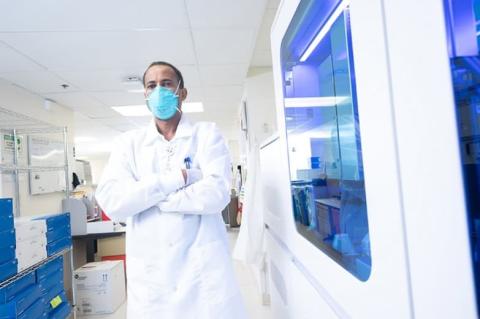
|
Education
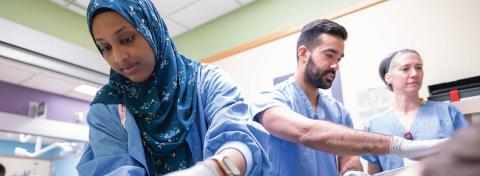
Hennepin Healthcare educates and trains doctors, nurses, EMT’s and other health professionals who go on to care for patients across Minnesota. In addition, we play an active role in developing and recruiting a workforce that better reflects the populations we serve.
Black Women with Stethoscopes
Originally published by Hennepin Healthcare (Winter 2023)
Envisioning a More Equitable Future
Black Women with Stethoscopes

While the Hennepin Healthcare Foundation’s support of diversity has broad goals, for Anya London, the programming has provided focus. Anya participated in the Talent Garden “Black Women with Stethoscopes” Youth Summit during her senior year in college. Getting the chance to hear from and learn from health professionals who looked like her made an impact.
“It's just important to see people like you working in the field, helping others,” said London. “I didn’t see a lot of black doctors growing up, or black nurses, and it feels like having more diversity helps them relate to patients in a different way and feel like they understand where you're coming from.”
London’s experience at the Youth Summit prompted her to apply for the Talent Garden Internship, which she completed the summer after high school. She said having a paid internship where she got hands-on training and mentorship was an incredible experience. She ended up getting her EMR certification as part of the program, and now she’s at Marquette University in her first year of Nursing School. She says the Internship gave her a leg up, preparing her for college.
“Having the EMR courses and having to study for them, it gave me really good study habits, and it prepared me for some of the things that I'd be going into,” she said. “I feel like it put me on a good path because I feel like I'm really succeeding in my first year, which is pretty great.”
London says she’s optimistic that the healthcare field is changing and becoming more diverse. While her nursing school class is still mostly white, she says it is the most diverse class Marquette has had, so she hopes the tide is starting to turn. She says she is interested in working in oncology or perhaps in trauma, and after graduation, she’d love to end up back at Hennepin Healthcare.
“I really like Minneapolis and when I was job shadowing some of the nurses and HR people told me, ‘Oh, we would love to have you back!’ So I'm definitely considering it,” she said. “I really like the work environment. All of the staff and all the patients that I encountered were super kind so being able to work there would be pretty cool.”
Reversing generations of inequity can’t happen overnight, but that doesn’t mean it can’t be done. Whether it’s planting seeds for future generations or opening new opportunities now, each effort adds up to a benefit that is even greater than the sum of its parts. With the support from our philanthropic family, diversity in our workforce will create more equity and better outcomes for all of the populations Hennepin Healthcare serves.
TeenHOPE Program - Planting Seeds and Reaping Rewards: How Philanthropy is Promoting Diversity in the Healthcare Workforce
Originally published by Hennepin Healthcare (Winter 2022)
TeenHOPE Program
Planting Seeds and Reaping Rewards: How Philanthropy Is Promoting Diversity in the Healthcare Workforce
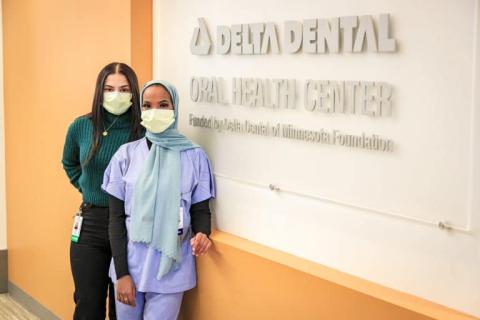
As a teen mother, Nasro Omar was facing significant challenges trying to complete high school while caring for her young daughter. All she could think about was graduating and finding a job. Then, she says, Hennepin Healthcare’s TeenHOPE Program found her.
“Someone from the program reached out to me and asked if I was interested,” said Omar. “They would come over once a week and ask how I was doing and help me out with things that I needed, like diapers and tutoring for school, and I really appreciated it. They opened my eyes to possibilities and they’re the main reason I’m going to go to college and graduate.”
Now, thanks to a grant from Delta Dental, Omar is focused on a career in health care. She is getting valuable experience working as a dental assistant while she is applying to college. Omar says her outlook has changed thanks to TeenHOPE, and she’s ready to make a difference.
“The main reason I’m doing this is because of my daughter, not only for being able to take care of her but setting a good example for her,” said Omar. “I never really got to see many diverse people in healthcare, but now I can get that experience and I can show that we can get these jobs and earn respect in the community.”
TeenHOPE is just one of a number of Hennepin Healthcare programs that are helping change the playing field in healthcare, encouraging diversity and creating a workforce that more accurately represents the community they serve. The initiatives work both “upstream,” trying to inspire young people to consider the healthcare field, and “downstream,” tapping into the talents of a more diverse community to fill important roles providing care and conducting research.
BUILDING BRIDGES TO HEALTH CARE CAREERS
In partnership with Hennepin County Health and Human Services, TeenHOPE reaches out to young mothers through a team of public health nurses who conduct home visits and provide assistance, helping the teens learn parenting skills and stay on course for graduation.
In addition to the in-home support, TeenHOPE runs a program called Pathways to Success to help participants develop a plan for the future. Pathways helps teens explore career paths and pursue the education and training that will help them succeed.
“Gaining access to a career in healthcare can require some barrier busting,” said Lania Caldwell, TeenHOPE internship coordinator. “You usually need some level of mentorship, connections and understanding about what these jobs are like. We know that people who are economically disadvantaged don’t usually have access to this kind of support and information, so we are able to help.”
Over the past five years TeenHope has helped nearly 200 people obtain their high school degrees. Of these, more than 130 have engaged in paid internships, and nearly 100 have gone on to earn college credits. For some, like Omar, the program has opened her eyes to a career where she can help others in her community.
“A few days ago, I was assisting with a dentist and we had a patient who was Somali,” said Omar. “I kept talking with her and she was able to ask me questions and I could tell she got to be more comfortable. She told me she was really happy to see me there, because she doesn’t see very many Somali people at the dentist.”
Caldwell says philanthropic support for TeenHOPE is accomplishing a number of critical goals. It is helping the participants launch into careers through meaningful, paid internships. It is improving the experience for patients, who see themselves better represented in care settings. Finally, it helps alleviate the severe health workforce shortages that have become particularly bad in the wake of the COVID pandemic.
“The teens we work with often grew up in this community and have come to Hennepin for dental visits and doctor appointments,” said Caldwell. “It’s not just that our participants look like the community they serve, they are the community and now they get to give something back.”
Talent Garden
Originally published by Hennepin Healthcare (Winter 2022)
Capturing the Imagination of Kids and Teens
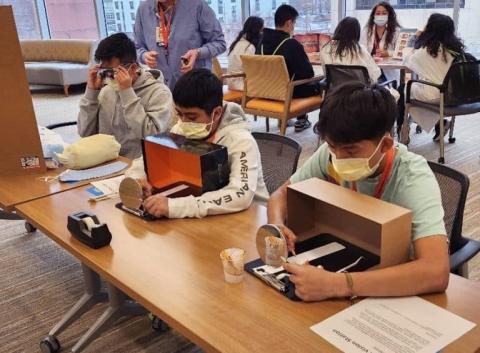
A big part of getting people to consider a career in healthcare is helping them see themselves in those roles. That’s the goal of another Hennepin Healthcare program called Talent Garden, which was launched with the help of philanthropic support in the wake of the murder of George Floyd. Hennepin’s Health Equity Department created this initiative to inspire teens from underrepresented communities to pursue health careers.
“There are so many studies that show a strong correlation between trusting your docs and having better health outcomes,” said Jim Peters, Hennepin’s Health Equity Program Development Manager. “If you see people in the doctor’s office who look like you, and have a similar background to you, you’re going to feel more comfortable and you’re more likely to keep coming back.”
Talent Garden engages students through Youth Summits, featuring hands-on activities that expose kids to healthcare careers. Over the last couple of years, with the support of sponsors like Blue Cross Blue Shield of Minnesota and Best Buy, Talent Garden has hosted Summits called, “Black Men with Stethoscopes,” “Black Women with Stethoscopes,” and “Latine Youth with Stethoscopes.” Plans are also in the works for a Summit for indigenous communities.
“Each of these events gives students a chance to meet with medical professionals who look like them and to try activities like CPR or working with simulators to get a feel for what these jobs are really like,” said Peters. “It shows them that these careers are not out of reach.”

In addition to the Summits, Talent Garden also offers career mentorship, job shadowing, and paid internships that not only give students an up close and personal look at health careers, but also give them valuable experience that can help them as they pursue college admissions. The internship is very hands-on, including 55 hours of emergency medical service training, allowing the students to work as certified Emergency Medical Responders once they turn 18.
Peters said all 20 members of the last internship class passed their EMR certification, and 19 of them said they planned to pursue a healthcare career. The 20th intern said he was more interested in health research. While the program is currently focused on teens, organizers say their ultimate vision is to provide support and resources that span decades.
“Maybe we can inspire kindergartners who have been grabbing at the stethoscope around their doctor’s neck since they were little kids saying, ‘Show me how that works,’” said Peters. “Then later we can connect with college students who are asking, ‘How do I prepare for pre-med?’ That’s how we build a pipeline that will truly change the workforce.”
EMT to Paramedic Program/International Physicians Residency Program/Diversity in Research
Originally published by Hennepin Healthcare (Winter 2022)
Creating Career Opportunities for Diverse Populations
As Hennepin Healthcare works to address healthcare workforce shortages, there are a number of initiatives aimed at recruiting and supporting a workforce that is more representative of the diversity of the community we serve.

Emergency Response
Hennepin Healthcare Emergency Medical Services (HEMS) has launched two efforts aimed at bringing in a more diverse workforce, including a scholarship program and an “EMT to Paramedic” initiative that helps train existing Emergency Medical Technicians to become fully licensed paramedics. There has been a national shortage of paramedics in recent years, so helping attract new and diverse candidates into this field is a high priority.
“These programs have brought some really high caliber people into our team,” said Martin Scheerer, Senior Director of EMS at Hennepin Healthcare. “Diversity is key to our growth and our efforts to provide the best possible service to the community.”
International Physicians
Another way to address the need for a more diverse workforce is by supporting and training immigrant physicians to provide care in the U.S. That’s why Hennepin Healthcare is collaborating with the Minnesota Department of Health (MDH) to support physicians who have come to Minnesota from other countries, placing them in residencies to train for primary care. By joining Hennepin’s Internal Medicine Residency, physicians who have already graduated and practiced in their home countries can help address Minnesota's primary care physician shortage.

Dr. Abubakar Hassan is one participant in this program. He grew up in a small village in Somalia and earned a scholarship to study medicine in Yemen. After medical school, he worked as a general practitioner in his home village before immigrating to the United States. His passion is to provide primary care to underserved patients, reduce healthcare disparities, alleviate their fears, and overcome language barriers between doctors and patients, making him a perfect fit for the Hennepin Healthcare mission.
"I am grateful to have been selected to train at Hennepin Healthcare,” said Dr. Hassan. “This program provides immigrant doctors living in Minnesota the opportunity to gain the necessary skills, experience, and knowledge to become well-trained internists."
Diversity in Health Research

The benefits of increasing diversity in healthcare go beyond delivering care. Healthcare research also benefits when people bring different backgrounds and perspectives to their work. The Hennepin Healthcare Research Institute’s (HHRI) Biomedical Research and Career Development Award supports the training of minority and women postdoctoral and junior faculty researchers. The grant, funded by 3M, is designed to provide a clear pathway to career opportunities in STEM fields, including biomedical research. The award not only helps open new career paths, it also helps HHRI address the health issues of a broader population.
Tayo Alese studied anatomy in Nigeria and conducted research on preeclampsia in South Africa before joining HHRI, where she’s researching how tobacco use affects the healing of wounds. As a recipient of the Biomedical Research and Career Development Award, she’s getting the opportunity to work on a question that can make a significant impact on health disparities.
Alese says she’s excited about how the grant will help her future research career. “I felt it's an opportunity for me to be able to use my skills,” she said, “ and I saw that I was also going to be learning much more.”
Health Equity
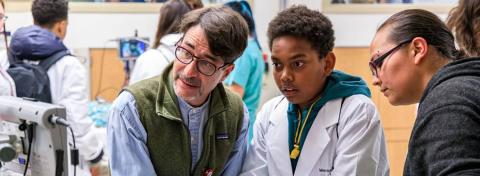
Providing exceptional care without exception means more than just caring for everyone who comes through our doors. Hennepin Healthcare is actively working to reach out to the surrounding community and break down barriers to care, developing innovative programs that welcome people from all backgrounds.
Pediatric Mobile Health Clinic - “The Patient will See You Now” Addressing Disparities by Taking Pediatric Healthcare on the Road
Originally published by Hennepin Healthcare (Winter 2023)
“The Patient Will See You Now”
Addressing Disparities by Taking Pediatric Healthcare on the Road

As a mother of six, Precious Adams understands the importance of keeping her kids healthy. She also knows how difficult it can be to travel to a doctor’s office. So when it was time for her one-year-old daughter, Zayda, and her 11-year-old son, Khadarion, to get vaccinated, she was relieved when the clinic came to her.
“It takes a lot of stress off of my plate, having that van pull up to get this out of the way,” said Precious. “If I had to do this appointment downtown, I would have to gather all the children up and bring them. Transportation is really hard with all the car seats and the stroller. So it was just amazing that they can come here and do that for me.”
On a brisk and overcast autumn morning, the Hennepin Healthcare Pediatric Mobile Health (PMH) Clinic parked in front of Precious’ home in Minneapolis. The blue and white van, emblazoned with superhero imagery, opened its doors and welcomed Precious, Zayda and Khadarion inside. During their hour-long appointment, Precious was able to get well-child checkups for Zayda and Khadarion, get them caught up on their vaccines, and even get a required sports physical done for Khadarion. As an added benefit, Precious received a supply of diapers and wipes to help with Zayda’s care.
Amy Green is a pediatric nurse practitioner who spends two days a week conducting home visits through the mobile clinic. She says visiting moms like Precious makes this one of the most rewarding parts of her job.
“I get to see how much it means to them and they tell me, ‘This is so convenient. This is so nice,’” said Amy. “It's fun for me because I can learn more about them than just seeing them in a patient exam room. Actually being able to drive up and see where they live makes you feel like you know them on more of a personal level.”
An Idea Born from the Pandemic
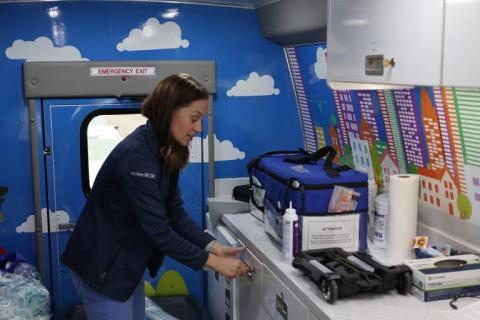
The PMH Clinic was launched in May of 2020, in the midst of the COVID pandemic. Shelter-in-place orders, combined with fear and uncertainty about the virus, prevented many people from venturing out for basic health care needs. When the Centers for Disease Control and Prevention (CDC) and the Minnesota Department of Health (MDH) issued warnings about significant drops in immunization rates, including a 70 percent drop in the Measles Mumps Rubella (MMR) vaccine in Minnesota, a group of Hennepin Healthcare staff members decided to find a way to help.
"We had to do something to make sure we didn’t have a measles outbreak on top of this COVID thing,” said Sheyanga Beecher, a pediatric nurse practitioner and medical director for Pediatric Mobile Health. “So we said, ‘Well, if patients aren't coming to us, we should go to them.’"
The early pandemic was a time of rapid innovation in health care. Hospitals had to move quickly to find new ways to meet patient needs without putting public health, or staff safety, at risk. Understanding the need for a rapid response around vaccinations, Sheyanga teamed up with Hennepin Healthcare pediatrician Dawn Martin, MD, to develop an innovative approach to close the vaccination gap. Generous support from donors to the Hennepin Healthcare Foundation allowed them to quickly turn their idea into action.
“It was this really unique window and time where the status quo was simply, ‘Do what needs to be done,’” said Sheyanga. “There were no committees. It was, ‘Put the cart before the horse and see what you can do.’ We worked with the Emergency Medical Services program, partnering with the community paramedics. They had this old white van that was about to be retired. It had four wheels and an engine that worked so we rolled out!”
PMH team members assembled lists of patients who were due for their shots, including those who had recently missed appointments. Many of those patients were from communities that the Department of Health had identified as the most vulnerable, with the greatest health disparities. Determined to make a difference for these families, the PMH staff put a stretcher into the back of the van to serve as an exam bed, bought a toolbox from Home Depot for vaccine supplies, collected diapers, food and toilet paper, and started reaching out to offer help. Sheyanga said she was amazed at how everyone stepped up during a very stressful time.
“I call them unicorns because they are phenomenal,” she said. “There are a certain set of people that not only are up for this task, but they thrive in this work and thrive in those patient interactions. There's a power dynamic shift that happens when you leave the walls of the healthcare system. You need to be flexible and you need to be comfortable in a landscape where you are not the top dog. The mission of this work is to get down to one-on-one human interaction, to connect with people to see what their needs are.”
Addressing Ongoing Disparities
As the PMH team worked to address the immediate health concerns of patients, they quickly realized the demand for care and the opportunities to make a difference extended far beyond the pandemic.
“At the beginning, we thought the patients would only need us to come to them because everything else was shut down, and once things opened up again they could go back to the way it was,” said Sheyanga. “Looking back, that was a bit elitist of us, I think. It was very privileged thinking to assume families will just pull themselves up by their bootstraps and it’ll be fine.”
In fact, the response to the mobile clinic exposed a greater need for this kind of connection with the community. With that in mind, the program expanded its scope and its programming. PMH launched Childhood Vaccine Pop-Up Clinics in schools to provide health assessments and vaccines. When staff members started noticing some vaccine hesitancy among patients they launched a COVID-19 Vaccine Speakers Bureau and conducted Town Hall meetings. With continued philanthropic support, they upgraded the run-down van for a more welcoming (and functional) vehicle that was branded with cartoon imagery to provide a fun, safe environment for families.
Since the launch of the program, the PMH program has screened more than 4,000 patients and administered more than 7,000 vaccines. Around 75 percent of the families served live in areas that are considered high on the Social Vulnerability Index (SVI), which takes into account factors including poverty, lack of vehicle access and crowded housing. In addition to vaccines, the patients are screened for social determinants of health (SDoH) such as food insecurity, housing instability, childcare and transportation concerns. More than 40 percent of mobile clinic patients screen positive for SDoH issues, allowing the healthcare workers to provide solutions and referrals to help with those needs.
“COVID really shined a light on where medicine has essentially fallen short,” said Ryan Hronoski, EMT for the Mobile Pediatric Clinic. “There is a gigantic need for this kind of connection and I know our patients are grateful. Just seeing the tears in their eyes, the comfort we can provide, the way we can follow up on what they need, it’s nice to be able to be with them in the community.”
Building Bridges, Earning Trust

COVID-19 wasn’t the only significant challenge facing the Hennepin Healthcare community during the time the mobile clinic was introduced. The murder of George Floyd and the social unrest that followed put a spotlight on issues of racism and inequity that have plagued this community for generations. During patient visits, PMH staff were on the front lines to witness the anger and distrust, to listen, and to try to build more positive relationships for the future.
“I don't know if serendipity is the right word, but we were there right when we should have been there,” said Sheyanga. “By taking care of the kids we are also having a multigenerational impact. You might have a newborn that is living with the maternal grandmother while the kids are going to school, or there are multiple family units within one household. We'll go to these houses and, yes, we'll see the child, but we're going to give Auntie her flu shot. Grandma might have a question about how she can be seen downtown for her heart health.”
Sheyanga says simply being out and visible can change the way people think about going to the doctor.
“How cool is it for people to see healthcare in a different light?” she said. “We’re not coming here to save someone's life because of a gunshot wound. We’re coming here to talk about your kids and how they're walking, and how they're riding their tricycle and how they're getting their shots. I think it reassured the community by showing them, ‘Yeah, this bad stuff is happening, but look at this good thing that's happening.’ Nobody can argue against healthcare for the child.”
Moving Beyond Pediatric Health
While the impact of the mobile clinic has been significant, the staff members say the experience has opened their eyes to even more possibilities. One area that could provide immediate benefits would be the addition of postpartum care to the clinic’s offerings.
“What we’ve picked up on is that it can be really hard for moms to get their own care,” said Sheyanga. “It’s difficult enough for families to get to a clinic for an appointment for their kid. Now they have to come in for themselves as well?”
According to the CDC, in 2021 the United States had one of the highest rates of maternal mortality in the country’s history. Eighty-four percent of pregnancy-related deaths in the US were judged to be preventable. While Minnesota’s maternal mortality rate is lower than the national average, Black and American Indian populations have disproportionately higher rates. Of the women who deliver babies at Hennepin Healthcare, fifty-eight percent do not come back for their postpartum visit. Again, those numbers are even worse for underserved communities. That means many of them are not getting mental health support, treatment for substance abuse, help with birth control, or other critical health assistance.
“We’re missing this huge opportunity for some of our most vulnerable patients,” said Sheyanga. “When you look at things like maternal mortality rates and infant mortality rates, they have risen for the first time in three decades. It’s mind-boggling in a way, but when I’m seeing patients in the community and the needs they have, I totally get it.”
Changing the Dynamic to Promote Healthy Communities
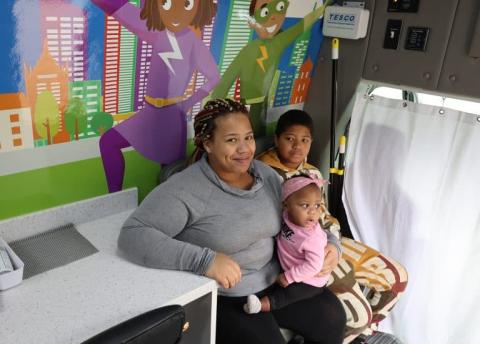
While the Pediatric Mobile Health Clinic is limited in the services it can provide, its role as a link to the healthcare system is vital in the effort to reduce disparities in care.
In one hour, Precious was able to talk with a nurse practitioner about sleep, nutrition and other important milestones for her children. Khadarion got his hearing and vision checked and was able to complete the physical he needed to play football and basketball. Because each appointment is scheduled for an hour, there was time to talk about any concerns Precious had or what future appointments might be necessary.
Of course, the kids also got their shots, which may not have been the highlight for Zayda and Khadarion, but it was a great relief to their mom.
“Yeah, I feel like it's something that's necessary and it needs to be done,” said Precious. “At the same time it's like, ‘Oh my babies!’”
Precious said she wasn’t sure what to expect when she made the appointment with the mobile clinic, but as soon as the van pulled up she knew it was a good decision.
“For anybody that is skeptical about trying this, it is a good experience,” she said. “I was calling around asking my family if they had heard about it and some of them have, some of them haven't. And I'm going to tell them, if you are thinking about doing it, go for it.”
The PMH team spends long hours preparing for the home visits, double checking addresses, which vaccines are needed, diaper sizes and other needs for each family. Amy Green feels the time spent on preventative care pays great dividends down the road.
“People are so grateful that we've taken the time to drive here. It's more personal. They establish a deeper relationship and more trust,” said Amy. “It is exhausting, with early mornings and then we get back and we are tired, but at the same time it’s just rewarding to be able to see them and see the difference it makes.”
For moms like Precious, the mobile clinic was more than a convenience. Having that connection to care is helping keep her entire family on a healthier path for the future.
Pediatric Mobile Health is powered by philanthropy with significant support from Blue Cross Blue Shield, Medica and individual donations. Learn more at: https://www.hennepinhealthcare.org/pediatricmobile/
Redleaf Center for Family Healing
Originally published by Hennepin Healthcare (Summer 2022)
We Need to Do Better by New Moms and Babies
Allie Pohlad champions the family’s $2.25 million donation to the Redleaf Center for Family Healing – and holistic care for new mothers

The pregnancy and postpartum period can be a time of heightened anxiety and depression for any woman – under the best circumstances. Postpartum depression is the most common complication of childbirth.
But as Allie Pohlad learned several years ago from an eye-opening New York Times article, the physical and emotional challenges of early motherhood can feel insurmountable to women who are also burdened by poverty or social and racial inequities.
“It struck me as so unjust,” says Allie. She was compelled to learn more – and to act.
Today she is the driving force behind the Pohlad family’s $2.25 million donation to Hennepin Healthcare’s Redleaf Center for Family Healing.
A socially conscious business entrepreneur, Allie is also co-owner of Truce, a fresh-pressed juice shop with three Twin Cities locations. She’s proud to be running a business that champions holistic health and wellness.
She and her partners aim to source foods and materials sustainably and to create rewarding jobs – all while fostering a respectful, positive environment for employees and guests.
She’s also embraced the family’s extraordinary commitment to philanthropy. Her grandfather, Carl, founded the Pohlad Family Foundation. But this third-generation Pohlad is striking out in new directions reflective of her own interests and values, including holistic health, social justice and gender equity.
Allie believes the principles – and practice – of gender equity apply to parenting, too. She’s convinced that both mothers and fathers deserve extended work leave in the formative first months after having a baby or adopting.
In fact, she made such a compelling case for that idea that now employees at Pohlad Companies are given 12 weeks of paid parental leave – whether they’re a new mom or dad. On average, U.S. companies offer four weeks paid leave to mothers.
“If you look at Scandinavian countries, we are embarrassingly behind,” says Allie. “Paid parental leave feels so fundamental to family building.”
With a master’s degree in holistic health, Allie wants to see more health care that emphasizes wellness and treats people as whole persons instead of a checklist of symptoms.
Her interests in integrated wellness and family-based parenting converged around Hennepin Healthcare’s Mother-Baby Program a few years ago, as she began researching Twin Cities resources for maternal health.
Allie toured the facility and was impressed by the vision and commitment of Dr. Helen Kim, its co-founder. She was also intrigued by Hennepin Healthcare’s partnership with Everyday Miracles, an on-call, culturally diverse doula service for birthing families.
“I really liked all the good things the Mother-Baby Program wanted to do for moms and families,” she says. “But their space was tiny and cramped. I thought that was a shame because of all their important education and outreach.”
The Redleaf Center for Family Healing will expand the capacity and services of Hennepin Healthcare’s Mother-Baby Program, Minnesota’s first intensive mental health program for pregnant and postpartum moms. Construction will begin in March 2020.
“Their approach feels hopeful and empowering – not condescending,” says Allie. “And the holistic aspect is so important.”
She’s also a fan of the center’s planned childcare services – a practicality that will allow new moms to take advantage of the important treatment services they need, even if they lack family backup or can’t afford a sitter.
As the mother of a toddler, Allie can relate to the pressures – and pleasures – of parenting. “I remember feeling a special kind of anxiety – like I’d never experienced before – in the middle of the night,” she says. That was before she’d even heard of postpartum anxiety.
She also recalls when the early demands of breastfeeding and caring for a newborn became a barrier to bonding. Finally, when their baby was about six months old, she was able to get more sleep, relax and enjoy the experience.
If having a baby could be challenging and isolating for her, she wondered – someone with all the resources and support she needed – how hard must it be for someone without support or even enough money for diapers?
“When you’re in the middle of it all, it’s impossible to believe that it will get better,” she says. “But getting the help and support you need can make all the difference to your mental health and ability to actually enjoy your baby.”
With the family’s gift to the Redleaf Center, she hopes more moms, dads and babies get off to a good start.
“The work that Redleaf Center is doing is important and valuable – but it isn’t just about helping moms,” says Allie. “We have to do a better job of supporting all families – and every new baby. And that work will never end.”
Aquí Para Tí Fosters Community, Connection, Confidentiality
Originally published by Hennepin Healthcare (Winter 2022)
Aquí Para Tí Fosters Community, Connection, Confidentiality
For two decades, Aquí Para Tí, or Here for You, has promoted positive youth development for Latine adolescents through delivering family-centered care. It all started when María Veroníca Svetaz, MD, MPH, was studying as a medical resident in St. Paul. Dr. Svetaz noticed that many Latine immigrant parents felt lost with their teenagers and that there were no structures in place to foster their connection.
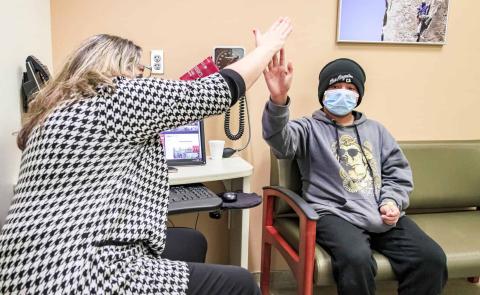
She dreamed of a clinic for both adolescents and parents – a place for teens to learn about their health in a trauma-informed and culturally responsive environment, and for parents to learn how to best support their children. That clinic, Aquí Para Tí, opened in 2002, recently celebrating its 20-year anniversary.
“We provide integral healthcare for adolescents in a holistic way, and we do this parallel care for parents because they’re such an important and influential part of their lives,” Dr. Svetaz said. “At the same time, we look at all the context such as trauma and social determinants of health. We try to take down all barriers with a knowledgeable team.”
She emphasized that confidentiality and connection are crucial to ensuring trust between healthcare providers and patients.
“The knowledge we have doesn’t matter if we’re not making our patients feel welcome and important, right at the door,” Dr. Svetaz said. “The ultimate goal is to celebrate and affirm their strengths, and to connect them to their school, family and community. Those are the things that create a healthy teenager.”
She added that the clinic can sometimes feel like working in the emergency department.
“Our teens are coming to us in crisis,” Dr. Svetaz shared. “People might think we’re treating acne or cramps, but it’s nothing like that. We’re there to heal their heart, as one mom described it, and help them process trauma.”
The feedback from patients has been both encouraging and humbling. New patients frequently say they came to Aquí Para Tí because of a suggestion from a friend or family member.
“When teens talk about the clinic, we hear that they feel like they’re the most important thing in the world when they’re with us. One parent said they can tell we care for their children as if they were our own. That one made me cry,” Dr. Svetaz laughed.
Kevin Villegas-Leon, 13, said he feels comfortable expressing himself to the Aquí Para Tí team.
“They’re trying to figure out how people’s lives are going and how they can help them. Everyone’s nice,” Kevin shared.
Yadira Rios-Gavilan brings her two teenage children to the clinic because she appreciates the focus on mental health and education.
“They’ve helped me too because they can explain why my daughter is feeling a certain way,” Yadira said. “They care about us and make us feel comfortable – like when we speak in Spanish. I’d recommend this clinic to anyone.”
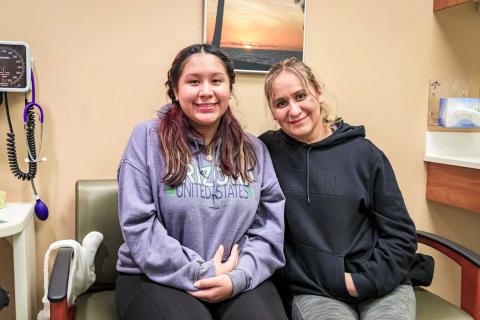
Her daughter, Katia, agreed and said she feels understood at Aquí Para Tí.
“I now understand what anxiety and depression mean,” Katia said. “The providers here don’t judge anyone.”
Even with all the improvements over the last two decades, there is still more work to be done, especially in the aftermath of the COVID-19 pandemic and the murder of George Floyd.
“We already had a crisis in teen mental health before,” Dr. Svetaz said. “COVID-19 grew that exponentially. Our teens have told us about the increase in racism they’ve experienced – hate speech and incidents at schools. Our Latine, African American and Somali communities have been affected the most.”
Enter a recent $250,000 Minnesota Department of Health grant awarded to Aquí Para Tí for comprehensive health recovery. With this grant, Aquí Para Tí team will formalize its Radical Healing Initiative to serve Latine, African American, and Somali youth and families in Hennepin County most severely affected by COVID-19. Drawing on trauma-response, cultural identity, and equity-focused care, the project will host listening sessions to create inclusive and integrative services. Those sessions will guide the creation of mind-body-soul healing group clinical spaces that will provide community-grounded wellness activities and trauma-informed identity-based healing.
“We can do counseling and medication, but we need to give our teens space to process trauma and tools to protect and celebrate their identity,” Dr. Svetaz said. “We can teach them mindfulness and how to use their body and music to create peace.”
For Dr. Svetaz, creating this mental health recovery clinic for teenagers has been a dream 40 years in the making, inspired by a mini summer camp where she guided teens in her rural Argentinian town, Alcorta.
“If we can teach our teenagers health and how to take care of themselves, think how different Hennepin Healthcare will be in the future,” Dr. Svetaz said.
The Radical Healing Initiative will be a crucial next step for Aquí Para Tí to build on how to best help our youth and families develop community resilience.
Could this program benefit you or someone you know? Learn more by focusing your smartphone camera on the QR code.
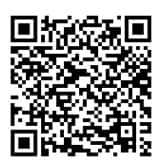
Philanthropic Support

Fulfilling our mission would not be possible without the support of individuals and institutions who share Hennepin Healthcare’s commitment to the community. Thanks to the work of the Hennepin Healthcare Foundation, generosity is transforming our ability to make a difference.
Announcing the Bush Foundation Grant for the East Lake Clinic
Originally published by Hennepin Healthcare (Summer 2021)
Announcing the Bush Foundation Grant for the East Lake Clinic

Thanks to a grant from the Bush Foundation, the Hennepin Healthcare East Lake Clinic will receive a makeover from the inside out. After the clinic sustained damages from social unrest last summer, it needed a new physical space and a new care approach.
A $204,559 Community Innovation Grant will support an 18-month community collaborative that will design a new trauma-healing primary care model. The model entails providers treating and viewing patients holistically and considers a patient’s safety, empowerment, voice, cultural and historical context, individual context, kinship network, and trust and transparency within the systems.
Ndidiamaka Koka, MD, medical director of the East Lake Clinic and model design co-leader, said that trauma can increase morbidity and affect long-term mortality.
“This project is a way the healthcare system can help patients heal from trauma,” Dr. Koka said. “To do that, we require a dialogue and a very close connection with the community.”
Ramla Bile, a grant-making officer with the Bush Foundation, said trauma-informed care is typically used in behavioral health or addiction services, so she was excited to see a proposal within a primary care clinic.
“We know the disparities and gaps in healthcare,” Ramla said. “We know the community is uniquely impacted,” and the uprising last summer and the presence of the COVID-19 pandemic created a “syndemic,” the intersection of two or more concurrent or sequential health threats. We see the value of this work and how it might change the healthcare ecosystem.”

The grant will fund capacity-building resources, the plan on what the practice will look like, space for co-learning, a design based on diversity, equity, and inclusion, the means to tap into the patient and community member voices, and the potential for the project to spread to other clinics and communities. The design will be created with input from patients, staff, and outside community groups.
Ramla said implementing the trauma-informed care model at the East Lake Clinic makes sense since the community has the greatest need to access healthcare for low-wealth areas and people of color. She thinks it has the potential to mitigate medical racism.
“It takes one good experience to help shift people’s mentality around how they trust and engage with systems,” Ramla said. “Making sure this is available to people of color who already experience bias and probably have some level of mistrust of systems because of their very real experience is important.”
Maria Kaefer, MD, a physician at East Lake Clinic and project co-leader, said, “Trauma-informed care needs to be implemented with primary care because it attends to emotional and physical health at all life stages, and is more accessible.”
“A lot of trauma-informed care is being done with 0-5-year-olds and families at the Hennepin Healthcare Redleaf Center for Family Healing and Aquí Para Tí to interrupt the generational trauma, but what if you’re 55? Is there still a way to heal from trauma? We feel that there is,” Dr. Kaefer said.
“We’re trying to put the model where the patient is,” Dr. Koka said. “If we can implement trauma-informed care with this group, then we really could affect some change.”
As a long-term project, the capacity-building planning project will take 18 months, followed by implementation and testing.
Groundbreaking for new facility supporting burn patients and their families - Firefighters for Healing
Originally published by Hennepin Healthcare (Summer 2021)
In the Moment for Families of Burn Patients and First Responders
On May 19, Hennepin Healthcare celebrated the groundbreaking of The Moment, a unique project that mixes residential, commercial, and nonprofit spaces. The entire second floor will be managed by Firefighters for Healing as a Transitional Healing Center, supporting families of burn patients and first responders receiving care at Hennepin Healthcare. Twelve fully furnished one-bedroom suites will be available at no cost. It will be a beautiful environment where a family member can rest and recharge. This Center will also accommodate patients who have been discharged so they have a comfortable and safe place to transition before heading home.
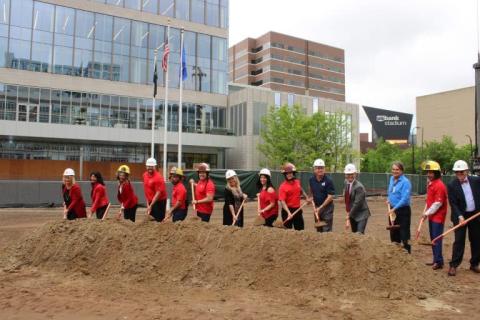
“We consider Firefighters for Healing an extension of our Hennepin Healthcare family”, shared Hennepin Healthcare Foundation President, Theresa Pesch. “They have stepped up to help our families when they have needed them with social, emotional, and financial support. We are thrilled to stand alongside them at the groundbreaking, and honored to raise support for this much-needed resource for our patient families & first responder community.”
Because of its profound impact, Hennepin Healthcare Foundation commits to raising $300,000 for this project and thanks the Homes for Heroes Foundation for its leadership gift of $100,000. Appreciation is also extended to board member Chris Sherman, his father George Sherman, and Sherman Associates for the role they have taken to make this project a reality. We also thank campaign co-chairs Jantze Haley and Rebecca Anderson for leading the fundraising effort.
None of this could be possible without the extraordinary vision of Firefighters for Healing and their close partnership with the doctors, nurses, and care team in Hennepin Healthcare’s renowned regional Burn Center.
Pohlad Family Supports the Redleaf Center: Allie Pohlad champions the family’s $2.25 million donation to the Redleaf Center for Family Healing
Originally published by Hennepin Healthcare (Winter 2020)
We Need to Do Better by New Moms and Babies
Allie Pohlad champions the family’s $2.25 million donation to the Redleaf Center for Family Healing – and holistic care for new mothers

The pregnancy and postpartum period can be a time of heightened anxiety and depression for any woman – under the best circumstances. Postpartum depression is the most common complication of childbirth.
But as Allie Pohlad learned several years ago from an eye-opening New York Times article, the physical and emotional challenges of early motherhood can feel insurmountable to women who are also burdened by poverty or social and racial inequities.
“It struck me as so unjust,” says Allie. She was compelled to learn more – and to act.
Today she is the driving force behind the Pohlad family’s $2.25 million donation to Hennepin Healthcare’s Redleaf Center for Family Healing.
A socially conscious business entrepreneur, Allie is also co-owner of Truce, a fresh-pressed juice shop with three Twin Cities locations. She’s proud to be running a business that champions holistic health and wellness.
She and her partners aim to source foods and materials sustainably and to create rewarding jobs – all while fostering a respectful, positive environment for employees and guests.
She’s also embraced the family’s extraordinary commitment to philanthropy. Her grandfather, Carl, founded the Pohlad Family Foundation. But this third-generation Pohlad is striking out in new directions reflective of her own interests and values, including holistic health, social justice and gender equity.
Allie believes the principles – and practice – of gender equity apply to parenting, too. She’s convinced that both mothers and fathers deserve extended work leave in the formative first months after having a baby or adopting.
In fact, she made such a compelling case for that idea that now employees at Pohlad Companies are given 12 weeks of paid parental leave – whether they’re a new mom or dad. On average, U.S. companies offer four weeks paid leave to mothers.
“If you look at Scandinavian countries, we are embarrassingly behind,” says Allie. “Paid parental leave feels so fundamental to family building.”
With a master’s degree in holistic health, Allie wants to see more health care that emphasizes wellness and treats people as whole persons instead of a checklist of symptoms.
Her interests in integrated wellness and family-based parenting converged around Hennepin Healthcare’s Mother-Baby Program a few years ago, as she began researching Twin Cities resources for maternal health.
Allie toured the facility and was impressed by the vision and commitment of Dr. Helen Kim, its co-founder. She was also intrigued by Hennepin Healthcare’s partnership with Everyday Miracles, an on-call, culturally diverse doula service for birthing families.
“I really liked all the good things the Mother-Baby Program wanted to do for moms and families,” she says. “But their space was tiny and cramped. I thought that was a shame because of all their important education and outreach.”
The Redleaf Center for Family Healing will expand the capacity and services of Hennepin Healthcare’s Mother-Baby Program, Minnesota’s first intensive mental health program for pregnant and postpartum moms. Construction will begin in March 2020.
“Their approach feels hopeful and empowering – not condescending,” says Allie. “And the holistic aspect is so important.”
She’s also a fan of the center’s planned childcare services – a practicality that will allow new moms to take advantage of the important treatment services they need, even if they lack family backup or can’t afford a sitter.
As the mother of a toddler, Allie can relate to the pressures – and pleasures – of parenting. “I remember feeling a special kind of anxiety – like I’d never experienced before – in the middle of the night,” she says. That was before she’d even heard of postpartum anxiety.
She also recalls when the early demands of breastfeeding and caring for a newborn became a barrier to bonding. Finally, when their baby was about six months old, she was able to get more sleep, relax and enjoy the experience.
If having a baby could be challenging and isolating for her, she wondered – someone with all the resources and support she needed – how hard must it be for someone without support or even enough money for diapers?
“When you’re in the middle of it all, it’s impossible to believe that it will get better,” she says. “But getting the help and support you need can make all the difference to your mental health and ability to actually enjoy your baby.”
With the family’s gift to the Redleaf Center, she hopes more moms, dads and babies get off to a good start.
“The work that Redleaf Center is doing is important and valuable – but it isn’t just about helping moms,” says Allie. “We have to do a better job of supporting all families – and every new baby. And that work will never end.”
